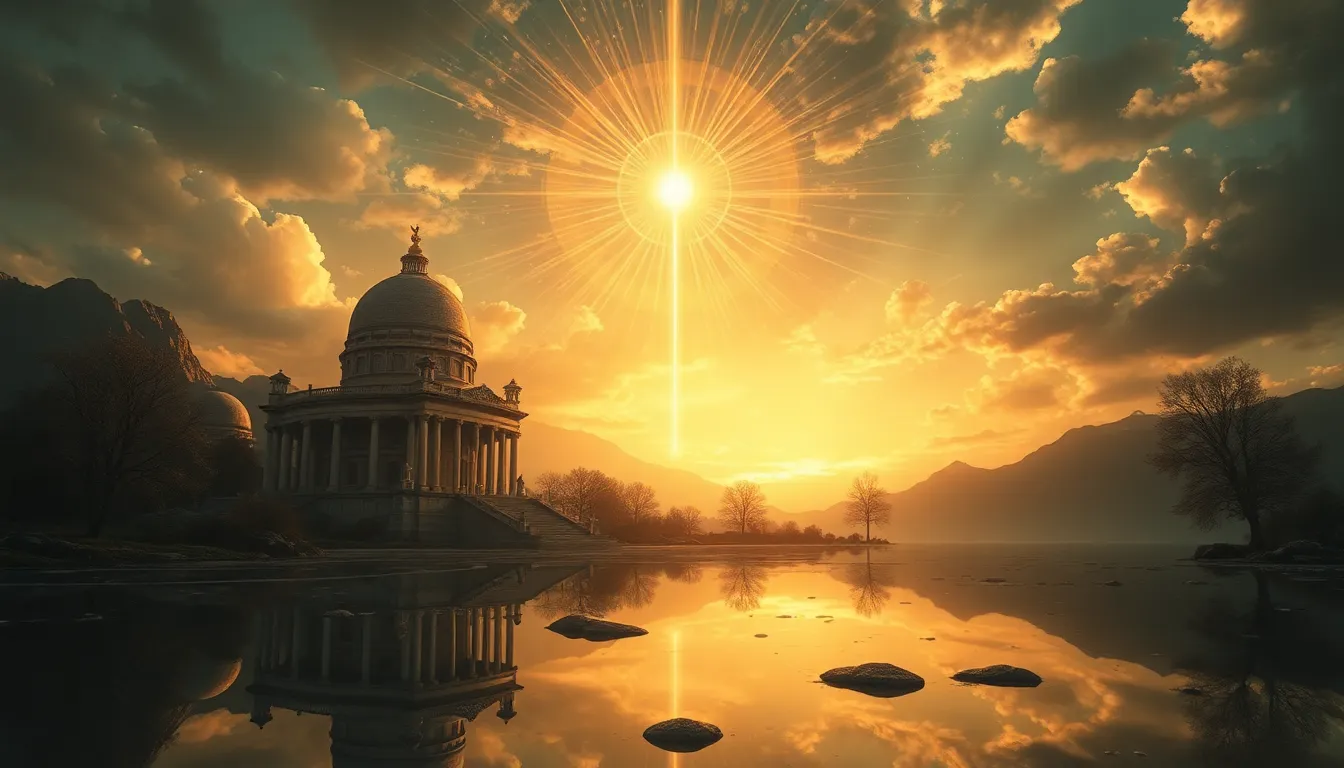The Divine Reflection: Sacred Places in Art and Mythology
I. Introduction
Sacred places are defined as locations that hold significant spiritual, religious, or cultural meaning. These sites are often seen as gateways to the divine, where the earthly realm intersects with the celestial. The importance of sacred places in art and mythology cannot be overstated; they serve as profound sources of inspiration for countless artists and storytellers throughout history. This article aims to explore the rich tapestry of sacred places, examining their historical context, mythological significance, artistic representations, and the modern interpretations that continue to evolve.
II. Historical Context of Sacred Places
A. Evolution of Sacred Spaces in Ancient Civilizations
The concept of sacred spaces has evolved significantly from ancient times to the present day. Early civilizations such as the Egyptians, Mesopotamians, and Indus Valley people constructed elaborate temples and religious sites that were central to their cultural practices. These spaces were not only places of worship but also centers for community gatherings and artistic expression.
B. Influence of Geography and Culture on Sacred Sites
The geographical context heavily influenced the location and nature of sacred sites. For instance, mountains, rivers, and caves often served as natural temples, revered for their majesty and mystery. Culturally, the beliefs and traditions of a society shaped how they viewed and utilized these spaces, leading to a diverse array of sacred sites across different civilizations.
C. Case Studies: Early Temples and Their Artistic Representations
- The Ziggurat of Ur: This ancient Sumerian temple stood as a monumental expression of divine worship, featuring intricate carvings that depicted gods and cosmic symbols.
- The Parthenon: Dedicated to the goddess Athena, this iconic structure mixes architectural genius with sculptural art, reflecting the values of ancient Greek society.
- The Great Pyramid of Giza: A testament to Egyptian engineering, its alignment with celestial bodies highlights the connection between the divine and the material world.
III. Sacred Places in Mythology
A. Overview of Mythological Concepts of Sacred Spaces
In mythology, sacred spaces often serve as realms where gods and humans interact. These locations are imbued with transformative powers, reflecting the beliefs of various cultures regarding the nature of the universe and humanity’s place within it.
B. Notable Sacred Sites in World Mythologies
- Mount Olympus in Greek Mythology: The dwelling place of the gods, symbolizing divine authority and human aspiration.
- The Underworld in Various Cultures: Often seen as a sacred realm for the dead, with unique representations in Greek, Egyptian, and Norse mythologies.
- The Sacred Grove in Celtic Mythology: A revered natural site where druids conducted rituals, emphasizing the connection between nature and spirituality.
IV. Artistic Representations of Sacred Places
A. Painting and Sculpture: Depicting the Divine
Artists have long sought to depict sacred places through painting and sculpture. These artworks often capture the essence of the divine, using symbolism and composition to evoke spiritual feelings. From the frescoes of the Sistine Chapel to the intricate carvings of Hindu temples, these representations serve to inspire and elevate the viewer’s experience.
B. Architecture as Artistic Expression of Sacredness
The architecture of sacred spaces is a form of artistic expression that conveys the sacredness of the site. Structures like cathedrals, mosques, and temples are designed not only for functionality but also to create an atmosphere conducive to worship and reflection. Their designs often incorporate elements that symbolize the divine, such as domes representing the heavens or spires reaching toward the sky.
C. The Role of Symbolism in Artistic Representations
Symbolism plays a crucial role in the artistic representation of sacred places. Common symbols include:
- Circles: Often represent eternity and the divine.
- Triangles: Symbolize the Holy Trinity in Christianity and the three realms of existence in various mythologies.
- Light: Used to signify the presence of the divine, guiding the faithful towards enlightenment.
V. Sacred Places as Pilgrimage Sites
A. Historical Significance of Pilgrimages
Pilgrimages to sacred places have been an integral part of religious practices across cultures. These journeys are often seen as acts of devotion, spiritual quests, or opportunities for communal worship.
B. Major Pilgrimage Locations and Their Artistic Legacy
- Mecca and Islamic Art: The Kaaba, located in Mecca, is the focal point of Islamic pilgrimage, known for its rich artistic history in calligraphy and geometric designs.
- Varanasi and Hindu Art: As one of the holiest cities in Hinduism, Varanasi is celebrated for its ghats and temples, which are adorned with intricate sculptures and murals.
- Jerusalem and Christian Art: Home to numerous sacred sites, Jerusalem has inspired countless artistic works, including mosaics and paintings that depict biblical events.
VI. The Intersection of Nature and Sacredness
A. Natural Landscapes as Sacred Spaces
Many cultures view natural landscapes as sacred spaces. Mountains, rivers, and forests are often considered embodiments of the divine, serving as places for spiritual reflection and connection to nature.
B. Artistic Representations of Nature in Sacred Contexts
Nature has played a significant role in the artistic representations of sacredness. Artists have captured the beauty of natural landscapes as reflections of the divine, emphasizing harmony and balance.
C. The Role of Nature in Mythological Narratives
In mythological narratives, nature often acts as a character, influencing the actions of gods and mortals alike. The sacredness of natural elements reinforces humanity’s connection to the earth and the cosmos.
VII. Modern Interpretations of Sacred Places
A. Contemporary Art and Its Reflection on Sacredness
In contemporary art, the interpretation of sacred places continues to evolve. Artists explore themes of spirituality, identity, and cultural heritage, often blending traditional symbols with modern techniques.
B. The Impact of Technology on Perceptions of Sacred Sites
Technology has transformed how people experience sacred sites. Virtual reality and digital art allow individuals to explore these spaces from afar, broadening access and understanding.
C. Revival of Ancient Practices and Their Artistic Expressions
There is a growing movement to revive ancient practices associated with sacred places. This revival often incorporates traditional art forms, reinforcing cultural identity and continuity.
VIII. Sacred Places in Literature and Poetry
A. Exploration of Sacred Themes in Literature
Literature often explores themes of sacredness, using sacred places as backdrops for stories of transformation, journey, and discovery.
B. Notable Works Highlighting Sacred Spaces
- The Divine Comedy by Dante Alighieri: A literary exploration of the afterlife, depicting sacred realms of heaven, hell, and purgatory.
- Siddhartha by Hermann Hesse: A narrative journey through various sacred places as the protagonist seeks enlightenment.
- Song of Solomon by Toni Morrison: Explores themes of identity and spirituality, with references to sacred spaces in African American culture.
C. The Influence of Mythology on Literary Representations of Sacredness
Mythology has significantly influenced literature, often serving as a source of inspiration for themes surrounding sacredness, morality, and human experience.
IX. Cross-Cultural Comparisons of Sacred Places
A. Similarities and Differences in Sacred Space Concepts
While different cultures have unique interpretations of sacred spaces, common themes often emerge, such as the reverence for natural elements and the importance of community within these spaces.
B. The Global Influence of Sacred Art and Mythology
Sacred art and mythology transcend cultural boundaries, influencing artistic expressions and spiritual beliefs worldwide. This global



